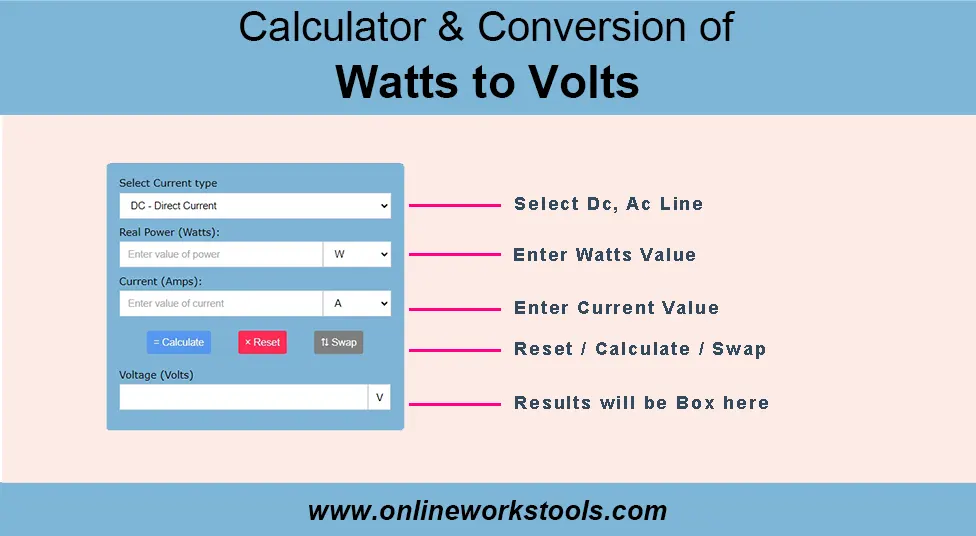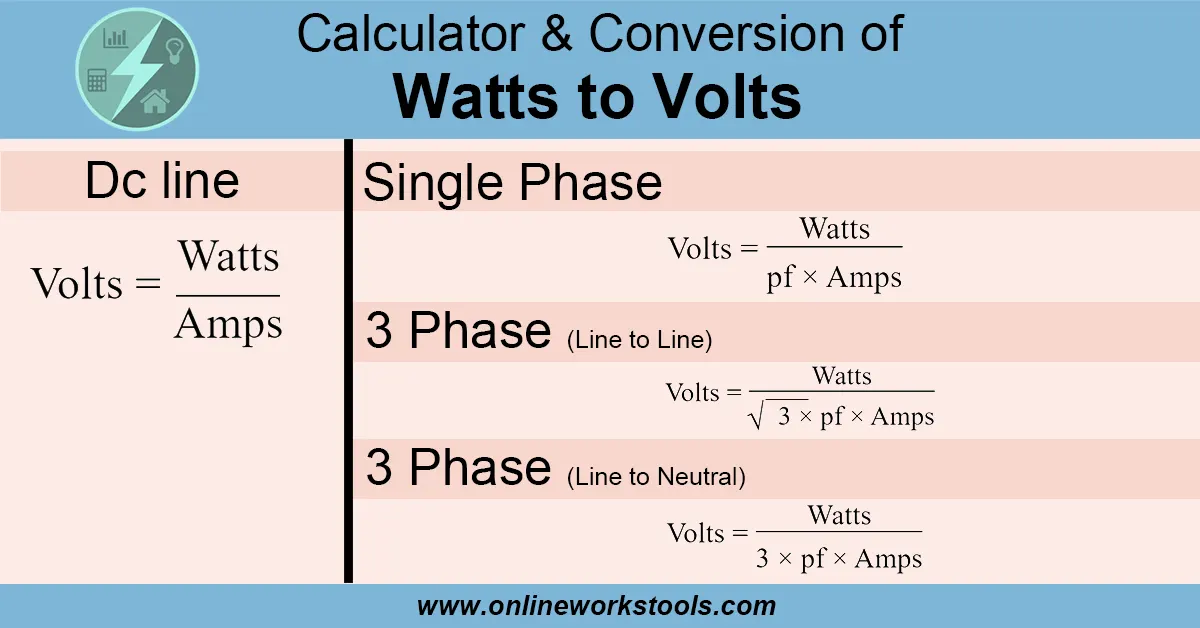Conversion using the Watts to Volts Formula
DC Watts to Volts Calculation formula
The Voltage V in Volts V is calculated as the Real Power P in watts w, divided by the Current I in amps A. Plug these values into the formula:
For Example, let's convert 60 watts to volts using a DC circuit with 6 amps of current.
Single Phase Watts to Volts Calculation formula
The RMS Voltage in Volts v is calculated as the Real Power P in watts w, divided by the Power factor in pf times the phase current I in amps A. Plug these values into the formula:
For Example, let's convert 1400 watts to voltage for an AC electrical circuit with 8 amps of current and a power factor of 0.8.
3-Phase Watts to Volts Calculation formula
Calculation with Line to Line voltage
The Line-to-Line RMS voltage VL-L in volts v is calculated as the Real Power P in watts w, divided by the square root of 3 times the Power factor in pf times the phase current I in amps A. Plug these values into the formula:
For Example, let's convert 800 watts to volts for an AC Electrical circuit with 10 amps of current and a power factor of 0.8.
Calculation with Line to Neutal voltage
The Line to Neutral RMS voltage VL-N in volts v is calculated as the Real Power p in watts w, divided by 3 times the Power factor in pf times the phase current I in amps A. Plug these values into the formula:
For Example, let's convert 1200 watts to voltage for an AC electrical circuit with 12 amps of current and a power factor of 0.8.
Suggested Reading
- Joules (J) to Kilowatts (KW) Conversion Calculator
- Amps (A) to kilowatts (KW) Conversion Calculator
- Kilovolt-amps (KVA) to Volt-amps (VA) Conversion Calculator
- Electron-volts (eV) to Volts (v) Conversion Calculator
- kilovolt-amps (KVA) to kilowatts (KW) Conversion Calculator
- Amps (A) to Watts (W) Conversion Calculator
- Kilowatt-hours (KWh) to Milliamp-hour (mAh) Conversion Calculator
- Kilowatt-hours (KWh) to Kilowatts (kW) Conversion Calculator
- Milliamp-hour (mAh) to Watt-hour Conversion Calculator
- Kilowatt-hours (KWh) to Watts (W) Conversion Calculator
- Volt-amps (VA) to Amps (A) Conversion Calculator
- Kilowatts (Kw) to Volts (V) Conversion Calculator
How to use Watts to Volts Calculator?
To use the above "Watts to Volts Conversion Calculator" follow the below steps:
1. Select Phase Type: Choose between DC Line, Single Phase Line, or 3 Phase Line by choosing the appropriate option from the dropdown.
2. Enter Real Power: Input the Real Power in watts or Load watts value in the specific input box. You can enter the value in millivolts mw, Watts W, kilowatts KW, & Megawatts MW by choosing the appropriate option from the dropdown.

3. Enter Current: Input the Current in Amps value in the specified input box. You can enter the value in milliamps mA, Amps A, Kiloamps kA, or Megaamps MA by choosing the appropriate option from the dropdown.
4. Select Voltage Type: Choose between Line to Line Voltage or Line to Neutral Voltage by choosing the appropriate option from the dropdown.
5. Enter Power Factor: Input the power factor of the Load in the provided input box. The power factor is a unitless value typically between 0 and 1.
6. Reset: Click the Reset If you want to reset the calculator to perform another conversion, you can click the Reset button, and all input fields will be cleared.
7. Calculate: Click the Calculate button to obtain the results. The calculated results will be displayed in the Results: section.
8. Swap: If you want to Swap the calculated to Exchange conversion, you can click the Swap button, and Calculate will be Exchange.
9. Result: The calculated "Result" will be displayed in the respective Result In output Volts output field.
Watts to Volts Conversion Chart
DC, Single-Phase, and Three-Phase Systems
| Input | Output | |||
|---|---|---|---|---|
| Current (Amps) |
Real Power (Watts) |
Voltage (DC) |
Voltage (Single-Phase AC) |
Voltage (3-Phase AC) |
| 10 | 100 | 10 V | 10 V | 5.77 V |
| 10 | 500 | 50 V | 50 V | 28.87 V |
| 10 | 1000 | 100 V | 100 V | 57.73 V |
| 20 | 1000 | 50 V | 50 V | 28.87 V |
| 20 | 2000 | 100 V | 100 V | 57.73 V |
| 50 | 5000 | 100 V | 100 V | 57.73 V |
| 50 | 10000 | 200 V | 200 V | 115.47 V |
Typical power factor values
Do not use typical power factor values for accurate calculations.
| Equipment and appliances | cos θ | tan θ | |||
|---|---|---|---|---|---|
| Motor | Common induction motor | loaded at | 0 % | 0.17 | 5.80 |
| 25% | 0.55 | 1.52 | |||
| 50 % | 0.73 | 0.94 | |||
| 75 % | 0.80 | 0.75 | |||
| 100 % | 0.85 | 0.62 | |||
| Lamps | Incandescent lamps | 1.0 | 0 | ||
| Fluorescent lamps (uncompensated) | 0.5 | 1.73 | |||
| Fluorescent lamps (compensated) | 0.93 | 0.39 | |||
| Discharge lamps | 0.4 to 0.6 | 2.29 to 1.33 | |||
| Ovens | Ovens using resistance elements | 1.0 | 0 | ||
| Induction heating ovens (compensated) | 0.85 | 0.62 | |||
| Dielectric type heating ovens | 0.85 | 0.62 | |||
| Welding | Resistance-type soldering machines | 0.8 to 0.9 | 0.75 to 0.48 | ||
| Fixed 1-phase arc-welding set | 0.5 | 1.73 | |||
| Arc-welding motor-generating set | 0.7 to 0.9 | 1.02 to 0.48 | |||
| Arc-welding transformer-rectifier set | 0.7 to 0.8 | 1.02 to 0.75 | |||
| Arc furnace | 0.8 | 0.75 | |||
| Power Factor Value Conversion Table | |||||
Frequently Asked Questions - Watts to Volts Conversion FAQs:
The wattage in one amp depends on the voltage of the system. Using the formula for DC conversion: Watts = Amps × Volts, at 120 volts, 2 amps would equal 240 watts. Remember, the relationship between amps and watts is directly influenced by the voltage.
Power factor is defined as the ratio of the average power supply in an AC circuit to the apparent power, which is the product of the voltage and current magnitudes. (1.77) Power factor = average power apparent power = p S. Power factor (PF) has a value between 0 and unity.
Volt is the measure of potential difference within 2 terminals of a conducting wire. A Watt is the rate at which electrical working is performed when a current of 1 ampere flows across the potential difference of 1 volt.
1 ampere is the current in which one coulomb of charge travels across a given point in 1 second. That's why an average lightning bolt carries around 5 coulombs of charge, even though its current may be tens of thousands of amps.
A measured in volts (V), stands as a fundamental concept in the realm of electronics, representing the electrical pressure that propels current flow through a circuit.

